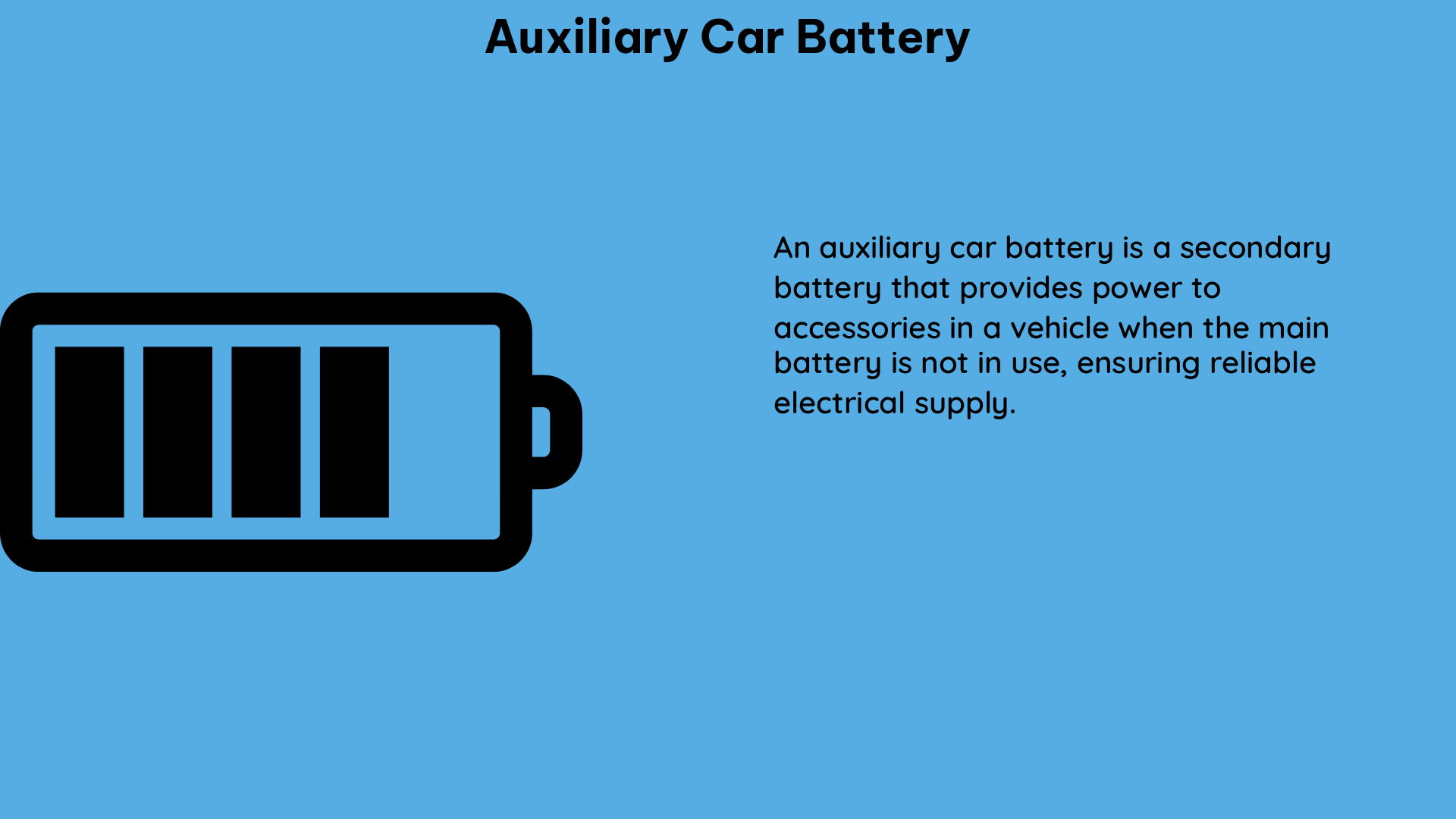An auxiliary car battery, also known as a secondary battery, is an additional battery installed in a vehicle to provide power to specific accessories or systems without drawing from the main starting battery. This is particularly useful for vehicles with high power demands, such as those with complex sound systems, refrigeration units, or other high-draw equipment.
Understanding the Types of Auxiliary Car Batteries
When selecting an auxiliary car battery, it is important to consider the different types available:
- Lead-Acid Batteries: These are the most common type of auxiliary car batteries. They are relatively inexpensive, but have a shorter lifespan and lower energy density compared to other options.
- Typical Capacity Range: 35Ah to 100Ah
- Cranking Amps: 300 to 800 CCA (Cold Cranking Amps)
-
Cycle Life: 300 to 500 cycles
-
Absorbed Glass Mat (AGM) Batteries: AGM batteries are a type of lead-acid battery that use a glass mat separator to hold the electrolyte. They offer improved performance, longer lifespan, and better resistance to vibration compared to traditional lead-acid batteries.
- Typical Capacity Range: 35Ah to 100Ah
- Cranking Amps: 400 to 1000 CCA
-
Cycle Life: 500 to 800 cycles
-
Lithium-Ion Batteries: Lithium-ion auxiliary car batteries are a newer technology that offers significantly higher energy density, longer lifespan, and faster charging times compared to lead-acid options.
- Typical Capacity Range: 20Ah to 100Ah
- Cranking Amps: 300 to 800 CCA
- Cycle Life: 1000 to 2000 cycles
Determining the Capacity and Power Requirements

The capacity of an auxiliary car battery is measured in amp-hours (Ah), which indicates how much power the battery can store. To determine the appropriate capacity, consider the power demands of the accessories or systems that will be connected to the auxiliary battery.
As a general guideline:
– For basic accessories (e.g., lights, phone chargers): 35Ah to 50Ah
– For more power-hungry systems (e.g., sound systems, refrigeration units): 60Ah to 100Ah
In addition to capacity, it’s important to consider the battery’s cranking amps and reserve capacity:
- Cranking Amps (CA): This measures the battery’s ability to provide a high burst of power to start the vehicle’s engine. A higher cranking amps rating indicates a stronger battery.
-
Typical Range: 300 to 1000 CCA
-
Reserve Capacity (RC): This measures the battery’s ability to provide a steady flow of power over a longer period of time. A higher reserve capacity indicates a longer-lasting battery.
- Typical Range: 60 to 180 minutes
Selecting the Appropriate Battery Size and Dimensions
When choosing an auxiliary car battery, it’s crucial to ensure that it fits properly in the available space and that the terminals match the vehicle’s electrical system. Consider the following factors:
- Battery Dimensions: Measure the available space in your vehicle and compare it to the dimensions of the battery. Ensure that the battery will fit securely without interfering with other components.
- Common Sizes: Group 24, Group 27, Group 31
-
Typical Dimensions: Length (7-13 inches), Width (5-7 inches), Height (7-9 inches)
-
Terminal Type: Check the terminal configuration of your vehicle’s electrical system and select a battery with compatible terminals (e.g., top post, side post).
- Common Terminal Types: SAE (Standard), BCI (Battery Council International), M6, M8
Installing and Connecting the Auxiliary Battery
Once you’ve selected the appropriate auxiliary car battery, follow these steps to install and connect it:
- Battery Placement: Choose a location that is easily accessible, protected from the elements, and secure. Avoid areas with high heat or vibration.
- Battery Mounting: Securely mount the battery using the appropriate hardware (e.g., battery tray, hold-down clamp) to prevent movement and ensure a tight connection.
- Battery Connections: Connect the positive (+) terminal of the auxiliary battery to the positive terminal of the vehicle’s electrical system using a heavy-duty cable. Connect the negative (-) terminal to a suitable ground point.
- Battery Isolator or Voltage Sensitive Relay (VSR): Install a battery isolator or VSR to prevent the auxiliary battery from draining the main starting battery when the vehicle is not running.
- Charging the Battery: Ensure that the auxiliary battery is properly charged before use. This can be done using a battery charger or by connecting the battery to the vehicle’s charging system.
Maintaining and Troubleshooting the Auxiliary Battery
To ensure the longevity and optimal performance of your auxiliary car battery, follow these maintenance tips:
- Regular Inspections: Visually inspect the battery for any signs of damage, corrosion, or leaks. Check the connections to ensure they are tight and free of corrosion.
- Charging and Monitoring: Regularly monitor the battery’s charge level and recharge it as needed to maintain a full state of charge.
- Cleaning and Maintenance: Clean the battery terminals and connections to prevent corrosion. Apply a thin layer of dielectric grease to the terminals to protect them.
- Replacement: Replace the auxiliary battery when it reaches the end of its lifespan, typically every 3-5 years for lead-acid batteries and 5-8 years for AGM or lithium-ion batteries.
By following these guidelines, you can ensure that your auxiliary car battery provides reliable power to your vehicle’s accessories and systems for years to come.
Reference:
- Auxiliary Battery Installation Guide – BatteryStuff.com
- How to Install an Auxiliary Battery in Your Car or Truck – 4x4Lab
- Selecting the Right Auxiliary Battery for Your Vehicle – Battery Council International

The lambdageeks.com Core SME Team is a group of experienced subject matter experts from diverse scientific and technical fields including Physics, Chemistry, Technology,Electronics & Electrical Engineering, Automotive, Mechanical Engineering. Our team collaborates to create high-quality, well-researched articles on a wide range of science and technology topics for the lambdageeks.com website.
All Our Senior SME are having more than 7 Years of experience in the respective fields . They are either Working Industry Professionals or assocaited With different Universities. Refer Our Authors Page to get to know About our Core SMEs.